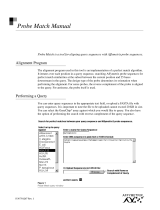
Table of Contents
List of Tables
Table 1-1: USB Device Parameters ............................................................................ 1-2
Table 2-1: Symbols for Backus-Naur Form ................................................................... 2-1
Table 2-2: Command Message Elements ...................................................................... 2-2
Table 2-3: Comparison of Header Off and Header On Responses.......................................... 2-3
Table 2-4: End of Message Terminator ........................................................................ 2-5
Table 2-5: Channel Mnemonics................................................................................. 2-6
Table 2-6: Cursor Mnemonics .................................................................................. 2-6
Table 2-7: Math Specifier Mnemonics......................................................................... 2-6
Table 2-8: Measurement Specifier Mnemonics ............................................................... 2-6
Table 2-9: Reference Waveform Mnemonics ................................................................. 2-6
Table 2-10: Numeric Arguments................................................................................ 2-7
Table 2-11: Quoted String Argument .......................................................................... 2-7
Table 2-12: Block Argument.................................................................................... 2-8
Table 2-13: Acquisition Commands. ........................ ........................ ........................ . 2-11
Table 2-14: AFG Commands.................................................................................. 2-12
Table 2-15: Alias Commands ................................................................................. 2-13
Table 2-16: ARB Commands ................................................................................. 2-13
Table 2-17: Bus Commands................................................................................... 2-14
Table 2-18: Calibration and Diagnostic Commands........................................................ 2-17
Table 2-19: Configuration Commands....................................................................... 2-19
Table 2-20: Cursor Commands ............................................................................... 2-21
Table 2-21: Display Commands .............................................................................. 2-23
Table 2-22: DVM Commands................................................................................. 2-24
Table 2-23: EmailCommands ................................................................................. 2-24
Table 2-24: Ethernet Commands ............................................................................. 2-25
Table 2-25: File System Commands ......................................................................... 2-26
Table 2-26: Hard Copy Commands .......................................................................... 2-27
Table 2-27: Horizontal Commands........................................................................... 2-27
Table 2-28: Mark Commands................................................................................. 2-28
Table 2-29: Math Commands ................................................................................. 2-29
Table 2-30: Measurement Commands ....................................................................... 2-30
Table 2-31: Miscellaneous Commands ...................................................................... 2-32
Table 2-32: Power Commands................................................................................ 2-35
Table 2-33: RF Commands.................................................................................... 2-43
Table 2-34: Save and Recall Commands .................................................................... 2-50
Table 2-35: Search Commands ............................................................................... 2-52
Table 2-36: Status and Error Commands .................................................................... 2-62
Table 2-37: Trigger Commands............................................................................... 2-65
3 Series MDO Oscilloscopes Programmer Manual v




















